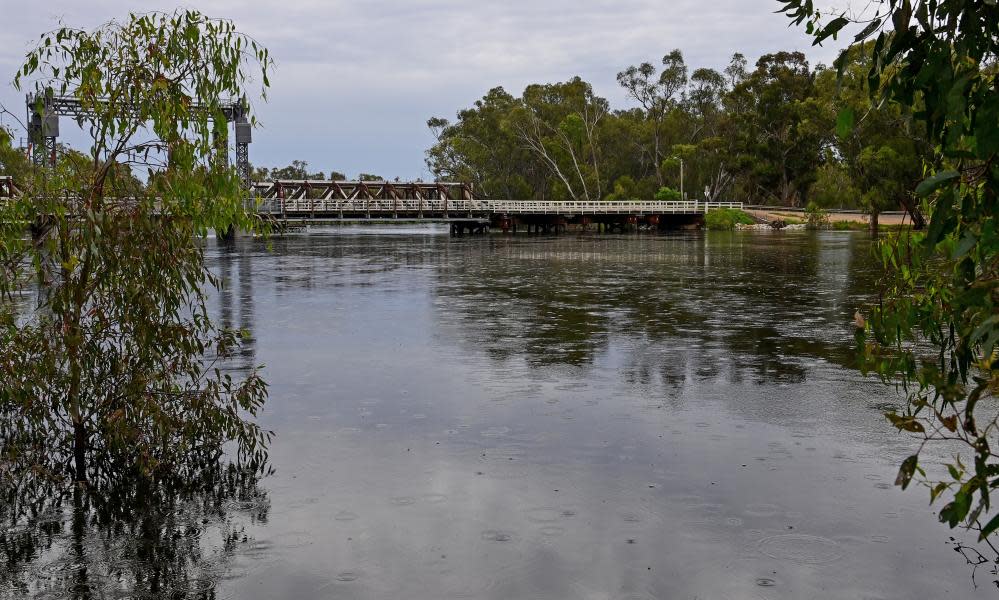Murray River towns could see brown tap water for months in wake of floods

Brown filtered water is likely to persist for months in Murray River towns from New South Wales down to South Australia, as communities continue to deal with the aftermath of major flooding.
The Murray River council in Moama was forced to reassure residents its filtered water supply was safe to drink after a string of social media complaints over murky tap water.
“Due to recent flood waters, council’s filtered water networks are being affected by discoloration in the river supply systems,” a spokesperson said. “This is likely to be an ongoing issue for weeks to come.
“The following may occur: toilet U-bends may look a little murky, bath water may look dirty [and] white sheets and clothes may not stay white when washed.”
Related: Temperatures forecast to reach mid-40s as heatwave hits northern Australia
Moama residents had posted pictures of brown stains and murky water glasses in the NSW border community.
“Who else’s water looks more brown than yellow this morning in Moama,” one user asked.
“My cats won’t drink it, have to fill their filtered thing up with bottled water …” another said. “Has left awful brown stains on my white clothes and sheets.”
The council said while the filtered water may look unpleasant, it isn’t harmful and the quality is within the requirements of the Australian drinking water guidelines.
“Council’s water team are actively flushing water mains across the region to assist [us] removing discoloured water from the network,” it said.
The Echuca-Moama region was hit with prolonged flooding last month, with the slow recovery process continuing for residents and council.
Moama’s water comes from the Murray and Edwards rivers and is treated at a water filtration plant.
Major flooding is still occurring at Barham, Wakool Junction, Boundary Bend and Wentworth on the Murray, with moderate flooding continuing at Torrumbarry, Euston and Mildura.
Flooding is at minor levels at Corowa, Echuca and Moama, with prolonged peaks expected downstream of Barham during December.
Stuart Khan, a professor at the University of New South Wales Global Water Institute, said the discoloration would be a problem that would “hang around for some time” and extend all the way down the Murray as the flooding slowly receded.
“We’ll probably see it for months,” he said. “It’ll be a challenge experienced all the way down to Adelaide in South Australia.
“They have a couple of water sources other than the Murray so if the water quality gets poor and it’s too difficult to treat, they might stop pumping and rely on other dams.”
Khan said the brown water was predominantly being caused by organic material releasing chemicals such as tannins.
While the water didn’t breach any chemical guidelines and was properly disinfected, it was hard to treat.
“There’s been months of accumulated organic material in the catchment prior to floods that washed into [the] Murray, and a high concentration of dissolved organics, like leaves and grass, [was] released,” he said.
“There’s so much of it, it’s difficult for the treatment plant when you’ve got a lot of poor quality raw water. It becomes more challenging.
Related: Australia has second wettest spring on record, with parts of country coldest in decades
“It’s dissolved, so filtration doesn’t help … When you’re overloaded, it’s difficult to not end up with the colour.”
Khan warned the water quality may worsen in summer as weather warmed.
Residents in Moama in southern New South Wales are complaining about brown water coming out of their household taps as the local government authority says it's an issue that is likely to go on for weeks. https://t.co/wunQ8Cnyli
— Stuart Khan (@stukhan) December 5, 2022
“Over summer, the problems with taste and odour might increase as bacteria grows in the warm weather. It gives the water a musty, earthy flavour.
“It’s not going to be flushing out the system, you’ll have more organics running off banks of [the] river.”
Khan said while discoloured water was acceptable for a short period, in the long term the aesthetic concerns became less manageable – particularly as residents tended to avoid tap water in favour of alcoholic or sugary drinks.
“There’s a distinction between a public health issue and an issue that makes water unpleasant to look at, taste or smell,” he said. “It’s only acceptable in short periods and there are good reasons for that.
“There’s a public health basis to [ensure] aesthetically favourable quality water … and staining clothes isn’t acceptable either.”

 Yahoo Movies
Yahoo Movies 
